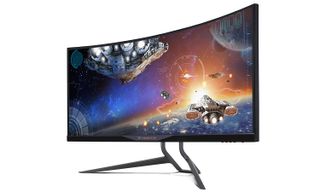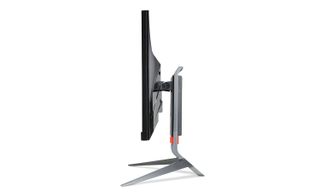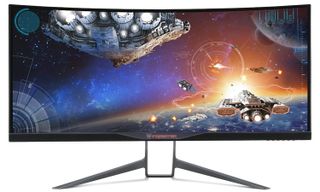Acer Predator X34 Review
The Acer Predator X34 curved gaming monitor provides an impressive level of immersion and strong G-Sync performance — if you're willing to pay up.
Why you can trust Tom's Guide

The Acer Predator X34's specs read like a wish list for gamers. A 34-inch, 3440 x 1440 curved display? Check. G-Sync and 100-Hz overclocking? You bet. Built-in LED lights? Yeah, why the heck not? Fortunately, all of these elements blend together wonderfully, resulting in a rich and immersive monitor that makes playing games an absolute joy — so long as you can afford the Predator's high price tag and put up with its pesky interface. In fact, we consider the Predator to be one of our best gaming monitors and best curved monitors.
Design
Acer's curved gaming monitor definitely earns its name, with a fierce-looking Predator logo below the display and a scaly, triangular pattern lining the monitor's mouthlike rear vent. It's just as sleek as it is savage, though, thanks to its jet-black paint job and slim, aluminum legs.

The Predator is even further distinguished by its set of bottom-facing LED lights, which will help illuminate your probably already-glowing keyboard and mouse. You can set the lights to glow red, green, blue, orange or white, as well as dictate whether they stay static, pulsate in and out, or — my personal favorite — ripple side to side. This is a nice touch, especially for those who swear by gaming gear that oozes with RGB backlighting.
In order to make sure the Predator fills up as much of your peripheral vision as possible, you can tilt the display 5 degrees forward or 35 degrees back, as well as raise or lower it about 5 inches up or down. You can't, however swivel the monitor left or right; this makes sense for a display with such a wide viewing angle, but I would have appreciated having an easy way to access the Predator's fairly hidden rear ports.
Ports and Interface
You'll find all of the Predator's inputs tucked away toward the bottom of the device's rear panel. The monitor's DisplayPort (required for G-Sync) and HDMI port should handle whichever PC, console or media box you want to attach to it, while the device's four USB 3.0 ports, USB Type B port and headphone jack should be more than enough for your peripherals.

While the Predator's port selection covers all of the essentials, I didn't enjoy having to crane my neck to get around its massive display in order to plug my gadgets in. Placing a few USB ports and a headphone jack on the side might have messed with the Predator's sleek design, but I'd prefer the extra convenience.
I had never been truly sold on curved gaming monitors, but that all changed the minute I booted up Batman: Arkham Knight.
You'll navigate the Predator's menus using six small buttons hidden under the right side of the screen, a process that took some getting used to. The buttons are tiny and fairly close to each other, which sometimes made it hard to figure out how to move left and right or select a submenu. I accidentally turned the Predator off more times than I would have liked.
Still, the monitor's actual menus are pretty intuitive. Once you press a button, you'll see large tabs for activating Game Mode, switching profiles, activating overclocking and switching inputs. Once you're in the Predator's main menu, you'll be able to adjust finer settings — such as brightness, contrast and color — as well as control the system's external lights.
Gaming Performance
I had never been truly sold on the concept of a curved gaming monitor, but that all changed the minute I booted up Batman: Arkham Knight on the Predator. I found myself immersed in Rocksteady's version of Gotham City like never before, enjoying a wide view of the game's beautifully moody skylines as I glided from building to building. Wide angles aside, the game looked simply stunning at 3440 x 1440 resolution, from the reflective neon lights that litter each street to each gritty, lifelike character model.

Fortunately, I found the Predator to be just as dependable for competitive games as it was for cinematic ones. Tactical shooter Rainbow Six Siege ran smoothly and played responsively, and in a game where a few shots can kill you, I appreciated having the extra field of view for spotting bad guys. I was able to distinguish every clump of snow and chunk of ice when battling on Hoth in Star Wars Battlefront, and had no problem picking out camouflaged snowtroopers in my peripherals.
The Predator is one of the first curved monitors to tout Nvidia's G-Sync technology, which is designed to eliminate stutters and screen tears by syncing a monitor directly with a PC's graphics card. The feature definitely made a difference during my playtime; I noticed some nasty horizontal lines when quickly looking up and down in Arkham Knight, a problem that activating G-Sync cleaned up immediately.
Multimedia Performance
Naturally, there's more to do on a curved, ultrawide monitor than just playing games at super-immersive resolutions. The Predator proved to be an impressive all-around multimedia display, whether I was watching movies or getting some work done.
Watching a 4K trailer for Elysium on the Predator made me feel like I was in a mini movie theater.
Watching a 4K trailer for Elysium on the Predator made me feel like I was in a mini movie theater, from the sheer sharpness of the film's futuristic landscapes to the engulfing 21:9 aspect ratio. Colors looked impressively vivid on Acer's monitor by default, though one colleague watching with me suggested that the blacks could be a bit deeper.
I found the Predator especially useful for multitasking on Windows 10, as I split the screen between a Google Doc and a Netflix video and never felt like I was sacrificing space on either side. If you want to run a game in windowed mode on one side while viewing your Twitter feed or Twitch chat on the other, Acer's display makes it pretty easy to do so.
Brightness, Color and Latency
Acer's curved gaming monitor was just as impressive in our lab tests as it was during everyday use. The display registered a strong 261 nits on our brightness test, topping our 223.5 gaming-monitor average.
The Predator delivered mixed color results. The monitor recorded a Delta-E color-accuracy rating of 1.77 (closer to 0 is better), beating the 4.9 average. The panel covered 98.9 percent of the sRGB color gamut, falling a bit short of the 103 percent average.
A bright, colorful monitor is no good if it's laggy, but fortunately the Predator proved to be as responsive as it is good-looking. The monitor netted a latency of 9.7 milliseconds, which is notably quicker than our 14.42-ms average for gaming displays.
Audio
While far from room shaking, the Predator's built-in 7-watt speakers are impressively loud and crisp. The monitor preserved the impact of most in-game sounds, from the rattle of an assault rifle in Rainbow Six Siege to the thunderous superhero gut-punches of Arkham Knight. You should probably pick up a good headset or set of speakers if you want to get as immersed as possible, but the Predator's speakers are perfectly suitable.
Modes and Features
The Predator features a handful of extra bells and whistles, including the ability to add a special crosshair overlay to the screen for some extra aiming help in shooting games. You have a choice of three different crosshair types, and while there's no guarantee that they'll help you play better, they all lined up perfectly with the in-game interfaces of shooters like Rainbow Six Siege and Borderlands 2.

Other features include an on-screen frame-rate counter, as well as Dark Boost, which allows you to lighten in-game environments without blowing the whole picture out. Once you've created your ideal combination of all of these settings (on top of color and brightness), you can save up to three custom profiles for booting up all of your favorite features at once.
While the Predator's refresh rate maxes out at 60Hz on standard settings, the monitor can be overclocked to a faster 100Hz for those looking to eliminate motion blur as much as possible. While I didn't notice much of a difference when playing games at 60Hz versus 100Hz, those with an especially discerning eye for smoothness may appreciate the option to ramp the rate up.
Bottom Line
If you're willing to shell out $1,299 for a gaming monitor, the Acer Predator X34 is worth every premium penny, and rightfully earned the top spot on our best curved monitors page. The monitor's rich 34-inch, 3440 x 1440 display makes it easy to get lost in your favorite virtual worlds, while the device's G-Sync capabilities and fast response times provide an optimally smooth experience for competitive players. Its bottom-facing LED lights probably aren't necessarily, but they sure as heck look cool.
The Predator isn't alone in the curved gaming monitor arena; BenQ's $999 XR3501 features a bigger 35-inch display, a faster 144Hz refresh rate and picture-in-picture capabilities, but lacks G-Sync and has a lower 2560 x 1080 resolution. Overall, if you're looking for pure immersion (and some pretty good looks) and don't mind splurging, the Predator X34 is one of the best high-end gaming displays you can get.
Sign up to get the BEST of Tom’s Guide direct to your inbox.
Upgrade your life with a daily dose of the biggest tech news, lifestyle hacks and our curated analysis. Be the first to know about cutting-edge gadgets and the hottest deals.
Mike Andronico is Senior Writer at CNNUnderscored. He was formerly Managing Editor at Tom's Guide, where he wrote extensively on gaming, as well as running the show on the news front. When not at work, you can usually catch him playing Street Fighter, devouring Twitch streams and trying to convince people that Hawkeye is the best Avenger.

